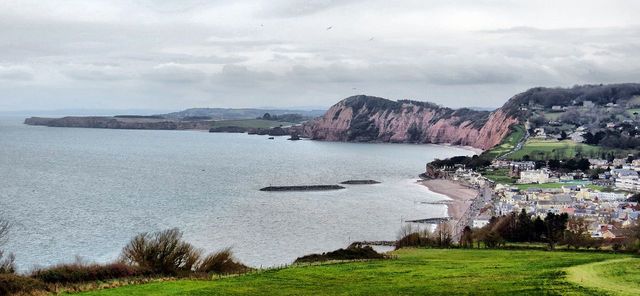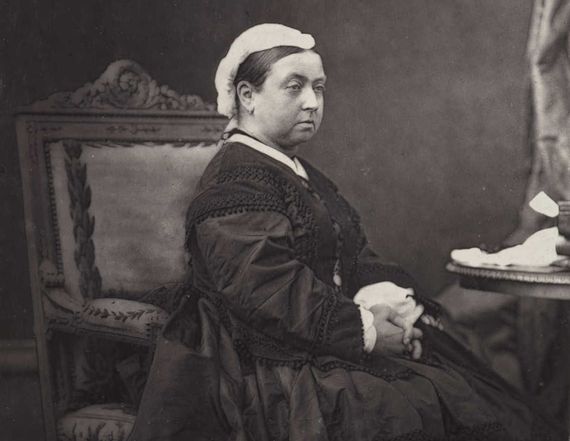
Sidmouth, Devon.Becks / CC
Steve Roberts looks at the long-standing history between Queen Victoria and the southeast county, and her earliest brush with death.
Bang! Smash! The violent detonation of a gunshot was instantly followed by the sound of breaking glass. The projectile entered the nursery, narrowly missing the head of Princess Victoria (the future Queen Victoria). Was this an assassination attempt? Not this time. Queen Victoria would survive eight attempts, in total, between 1840 and 1882. This close call, however, in the winter of 1819-20, when she was but a wee bairn, was ‘merely’ a near-tragic accident.
Bells were ringing and bands playing. It was a big thing, after all, when royalty came to stay. Sidmouth was all a flutter in December 1819 when the Duke and Duchess of Kent arrived with their entourage, which included their little daughter Victoria, who was sixth in line when she was born yet destined to be queen. They actually arrived on Christmas Eve in the midst of a snowstorm.
Edward, Duke of Kent (1767-1820), his wife, Victoria (or Victoire) of Saxe-Coburg, and the chubby little tot, settled down at Woolbrook Cottage, which is today the Royal Glen Hotel. It had once been incongruously King’s Cottage, named after a Mr. King (of Bath) who had gentrified an existing 16th-century farmhouse back in the 1770s, transforming it into a Gothic villa with Regency interiors. It was in 1817 that the house was purchased by Maj. Gen. Edward Baynes, who extended the grounds and made other improvements. This is when it became Woolbrook Cottage (sometimes Glen).
Having been born in May 1819, little Alexandrina Victoria was only seven months old when she arrived in Devon, which means this was Victoria’s first holiday.

Queen Victoria was just seven months old she arrived to Devon on her first holiday.
There was a nurse, of course, who took her out to “take the air”. There was a groom too, to make arrangements. But overseeing everything was Capt. John Conroy, the Duke’s chief administrator, and a former army officer. What he had to contend with was an establishment of some 15 rooms. All operated like clockwork under Conroy’s ever-watchful eye, although the accommodation would have been considerably smaller than what the spoiled Kents were used to.
Sidmouth was a resort that was prospering. The regular population was around 3,000, but the summer season saw this figure swollen by the well-to-do, with 300 or so of the well-heeled rocking up to participate in sea-bathing.
The Duke of Kent had a practical reason though for choosing Sidmouth for his family’s holiday. His bizarre household practices had racked up debts and Woolbrook offered a cheap sojourn. Apparently, he was full of self-importance and extravagance, so constantly indebted, and unlikely to be bailed out by an unsympathetic Prince Regent (the heir to the throne, occupied by George III). Devon and Sidmouth offered temporary respite from the Duke’s many creditors. The Duchess was also suffering from rheumatism after giving birth to Victoria and it was felt that the Sidmouth sea air would benefit both her and the little one.
Of course, a royal party abroad meant a bunch of staff. As Woolbrook was too small to house them all, the family’s servants were scattered around the town (or village as it would have been considered then), which presumably was of considerable benefit to the Sidmouth shopkeepers. One Mr. Taylor had the signal privilege of making Victoria’s first pair of shoes.
Word soon got around about the royals and townsfolk eagerly sought a glimpse of the tiny tot being perambulated about the grounds for her daily airing. Apparently, the Duke remarked that she should be taken good care of for “she might yet be Queen of England’” a remarkably prescient thought that possibly didn’t extend to
local lads taking inadvertent potshots at her.
Those who’ve watched the series "Victoria" on TV will be familiar with her half-sister, Feodore of Leiningen (1807-72), who calls Victoria ‘Drina’ (from Alexandrina). Well, she was among the party too. At this time, 12 years old, she was one of several in the group to fall ill at the hands of the bracing Devon winter weather. Including young Victoria who also caught a cold.
This was a vacation without happiness, for Victoria’s father became very ill, dying in Sidmouth of complications, having caught a heavy cold, which turned to pneumonia. He’d unwisely not changed out of saturated boots after he’d returned from a yomp in the thawing snow. One of the visitors during the crisis was Victoire’s brother, Leopold (1790-1865), who became the first King of the Belgians, in 1831, as Leopold I.
The Duke had managed to sign his last will and testament before passing away on 23 January 1820, ironically, in the process, pushing his tiny daughter one step closer to the throne.
Devon had not seen anything like it. If it wasn’t enough to have had a royal family holidaying here, the county now hosted a lying-in-state for several days, with some 3,000 people paying their respects in Sidmouth (pretty much the whole population one assumes). The Duchess’s brother, Leopold, coughed up the funds to pay off the local debts so that the coffin (seven-foot-long and weighing in at more than a ton) could actually be removed to Windsor. The Duchess and her party departed Sidmouth on 25 January 1820, in a line-up of eight carriages.
The Duke’s funeral meanwhile would be delayed by the death of the King just six days after the Sidmouth sadness. It was 7 February when the impressive funeral cortege finally departed Sidmouth, for Honiton, and ultimately, after three overnight stops, for Windsor, with the streets lined by silent, grieving folk.
There could have been an even more dramatic conclusion to the royal visit, hard as that may be to imagine. The toddler princess was playing in her nursery (today’s Princess Room at the hotel) when that gunshot rang out. No, not an early assassination attempt but a local youth taking pot-shots at birds. He smashed a window but narrowly missed the royal head. The window in question can still be seen, around the back of the hotel, the pane where the shot entered having colored glass, in an otherwise clear glass window.
In fact, there are lots of artifacts around the Royal Glen to remind us of those royal visitors. There’s an impressive royal coat of arms proudly displayed at the front of the building. Made of wood, it was believed, at one time, that the arms had been installed in the 1930s, however, a 1990s renovation revealed an inscription on its reverse, reading “J.R. Anderson, carver, 1879”, which puts it 60-odd years after the royal visit, during the year of the French Revolution.
There’s also a commemorative plaque above the main entrance, erected to celebrate Victoria’s diamond jubilee of 1897. There’s also a blue plaque setting out some of the building’s interesting later history. It became both an orphanage and boarding house before embarking on its current life as the Royal Glen Hotel. It is Grade I Listed and has been ‘listed’ since 1951 (there are 360 listed buildings in Sidmouth in total). During WW2, the hotel was also a convalescent home for RAF personnel.
Now, the county of Devon, which had almost proved her nemesis, continued to play its part in Victoria’s life, in the years that followed. When she married Prince Albert, as a 20-year-old, on 10 February 1840, her wedding dress included Honiton lace. Honiton, just ten miles north of
Sidmouth, is as synonymous with lace as Melton Mowbray is with pork pies and Cornwall with pasties. The making of Honiton lace, a type of bobbin lace, was not confined to the town of Honiton, as the lace that adorned Victoria’s dress was actually worked at Beer, which is also some ten miles from Honiton, but east of Sidmouth, back towards Seaton, and then the county of Dorset. Victoria’s choice of Honiton lace was, unsurprisingly, a major boost for Devon’s lace-making. By royal approval, one might say.
Queen Victoria, of course, survived not only that early pot-shot, but also all those assassination attempts, to become the UK’s longest-reigning monarch, at 63 years and 216 days, snatching the record from, of all people, her very own grandfather, George III, who’d achieved a mere 59 years and 96 days, some of them whilst not in possession of his faculties. Victoria’s record has been surpassed by HM Queen Elizabeth II, who went past the 67-year mark in February 2019.
Where to stay
Royal Glen
Stay where the young Princess Victoria spent her first holiday in the winter of 1819-20. You can even stay in her nursery if you wish. There are 32 comfortable bedrooms, each different in shape, size, and furniture, in a hotel that retains its Victorian elegance, tucked away in quiet Glen Road.
Royal York & Faulkner Hotel
Construction of Sidmouth’s first purpose-built hotel, the Royal York, began in 1807. Its most celebrated guest was “Bertie”, the Prince of Wales (future Edward VII), who stayed in September 1856. There are individually styled bedrooms and suites, many with sea views, and some with balconies.
www.royalyorkhotel.co.uk
Getting there
The nearest airport to Sidmouth is Exeter International Airport, which is ten miles away. The B3184 and A3052 lead to Sidmouth.
Sidmouth no longer has a railway station (closed 1967). The nearest station is Feniton, once the junction for the Sidmouth branch, which is just over 7¼ miles away (it’s on the mainline between London Waterloo and Exeter).
By road, you’ll either take the A3052 from Exeter (including the airport, as above) or the A358, then A3052 from Axminster, or the A375 from Honiton.
* Originally published in 2021, updated in 2023.





Comments